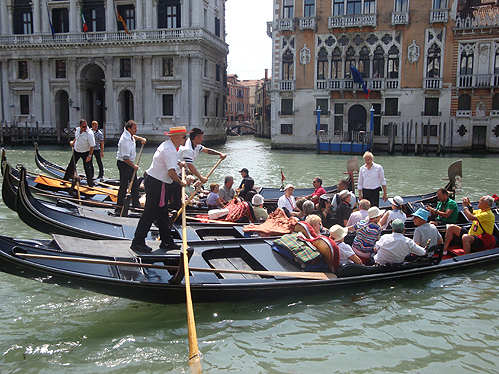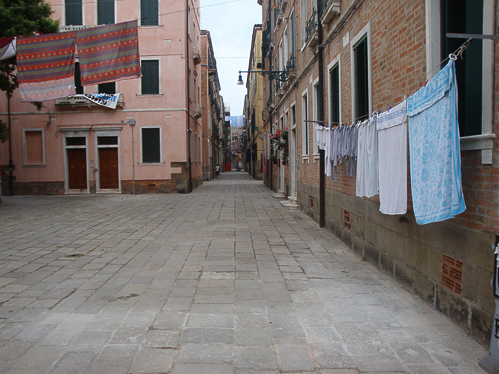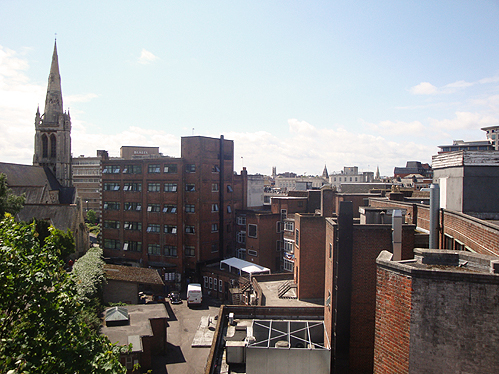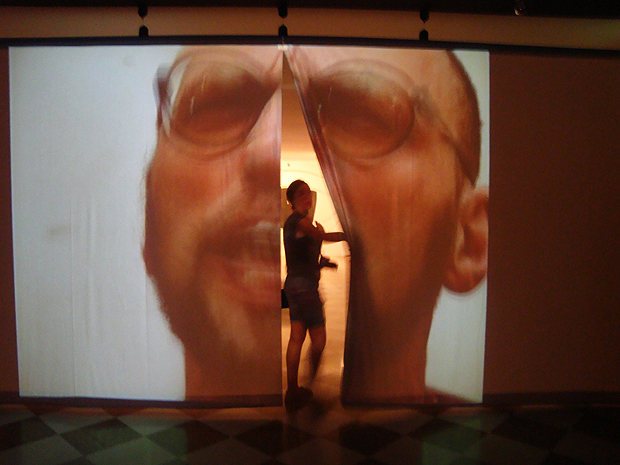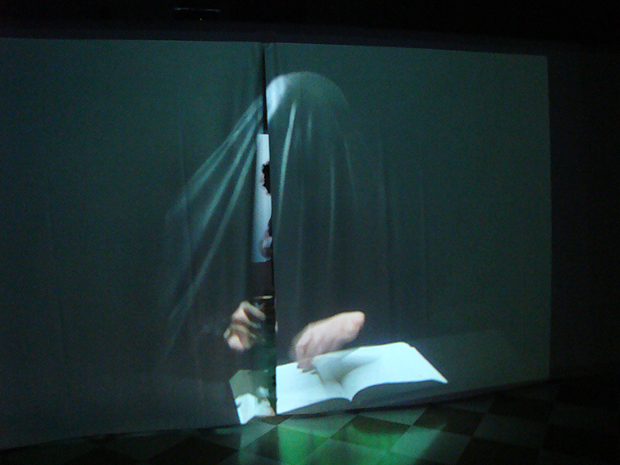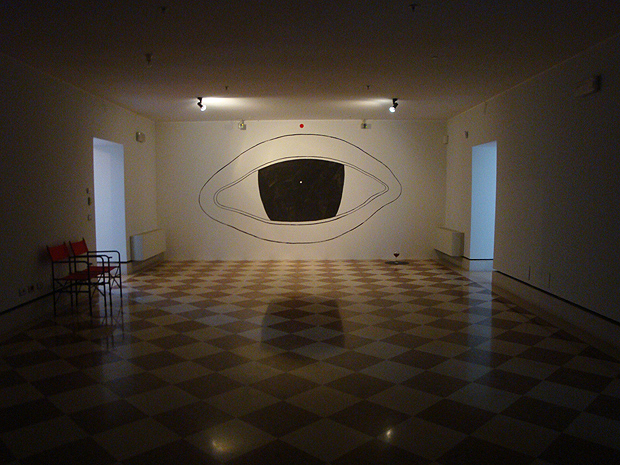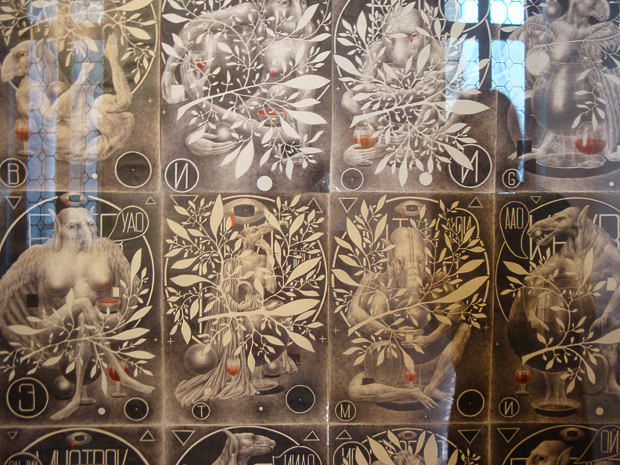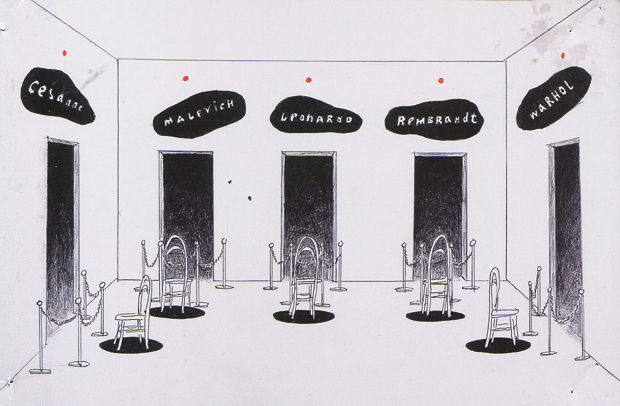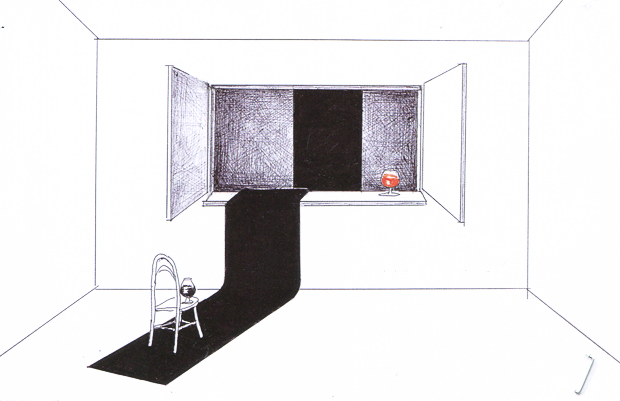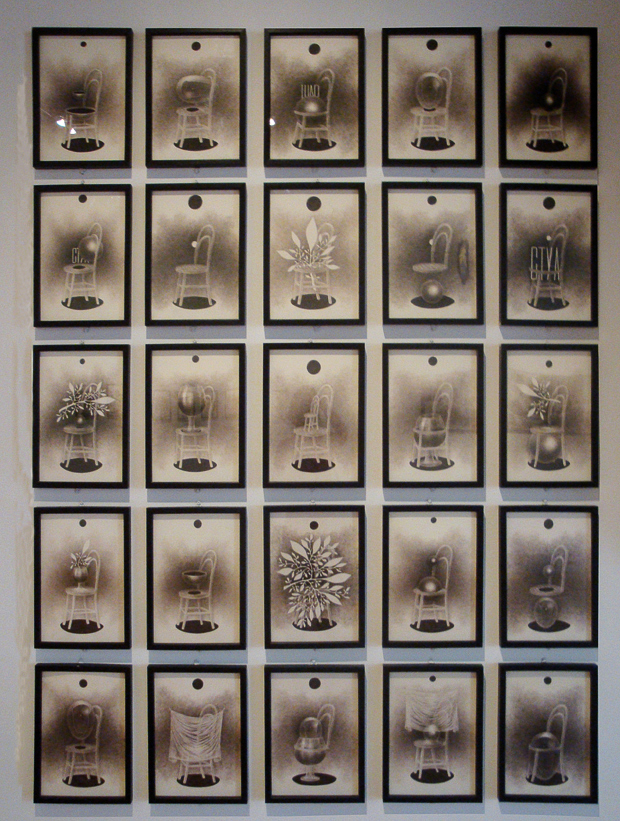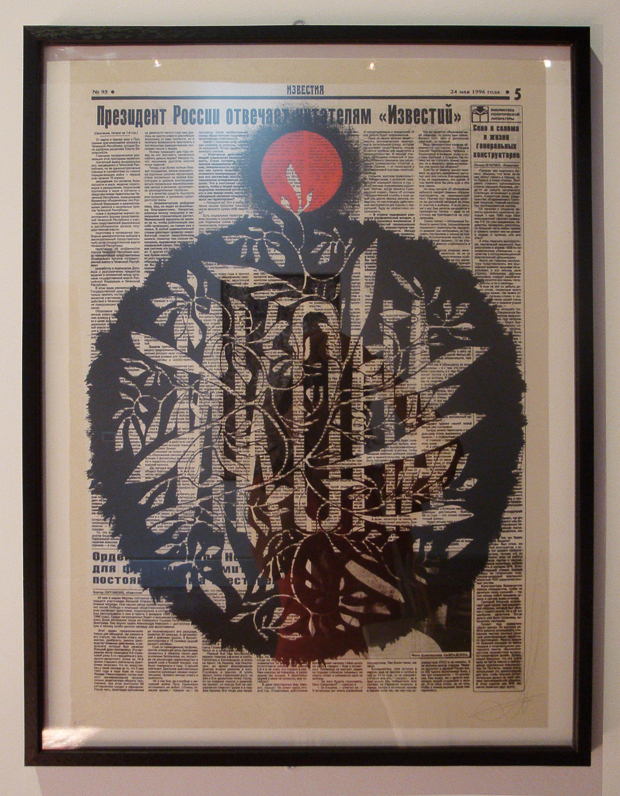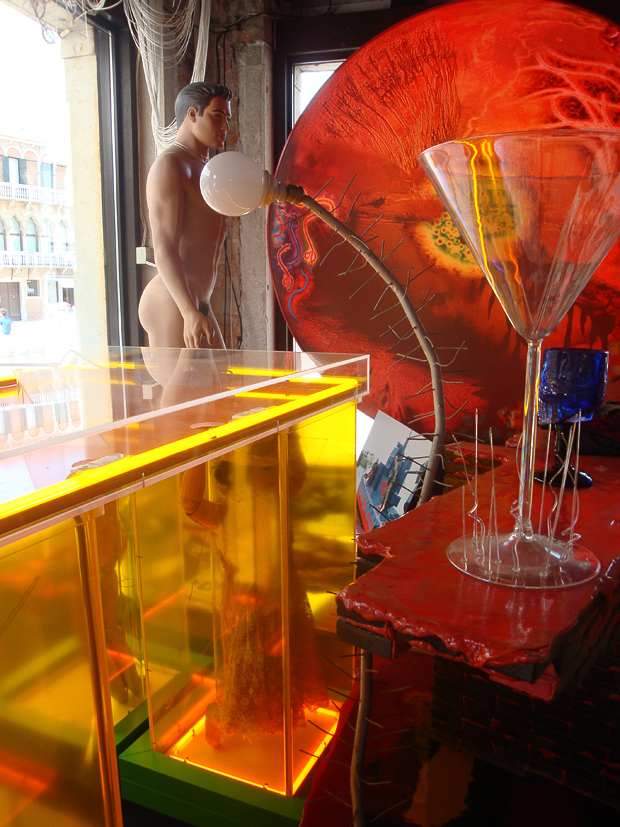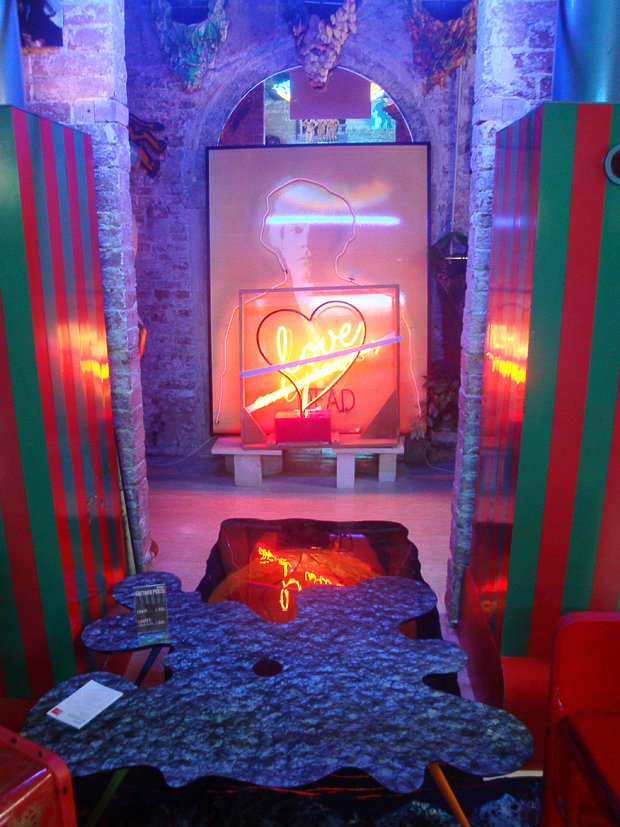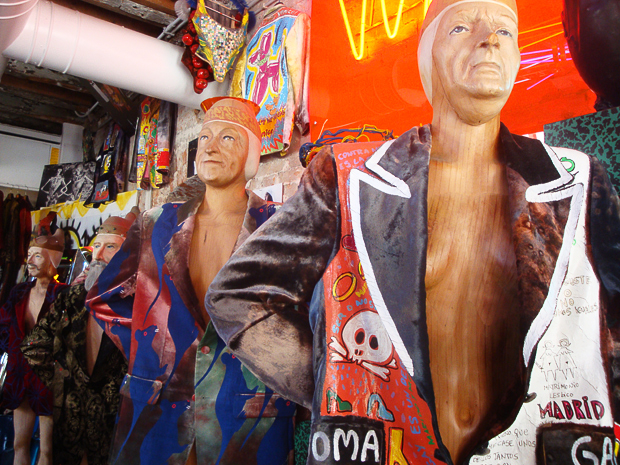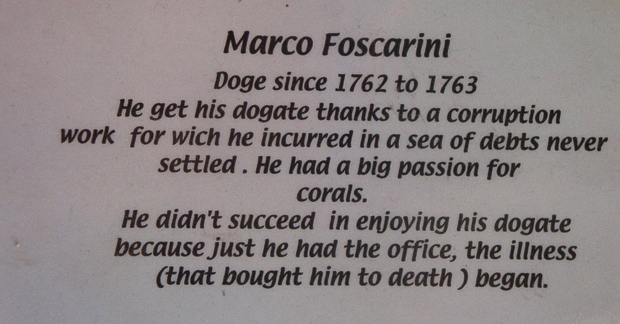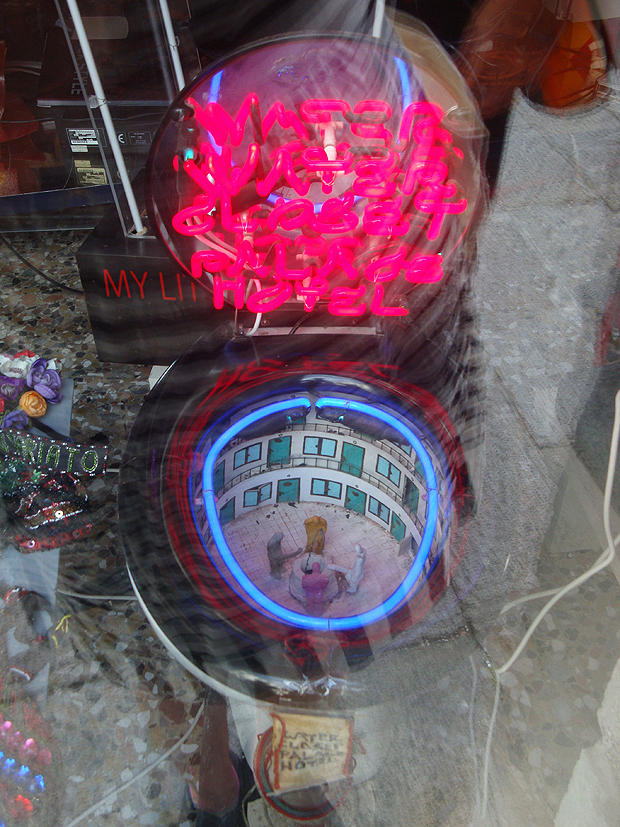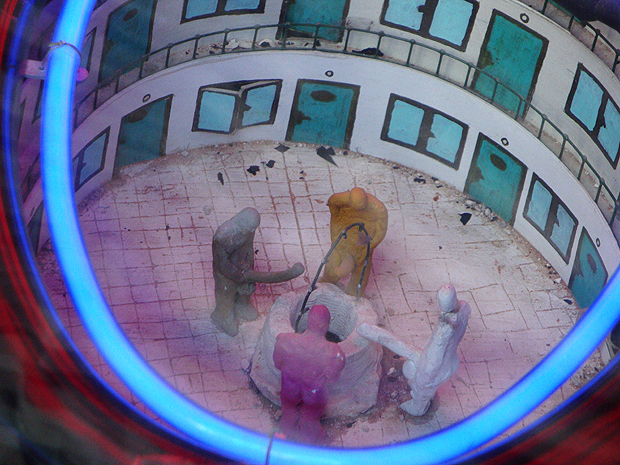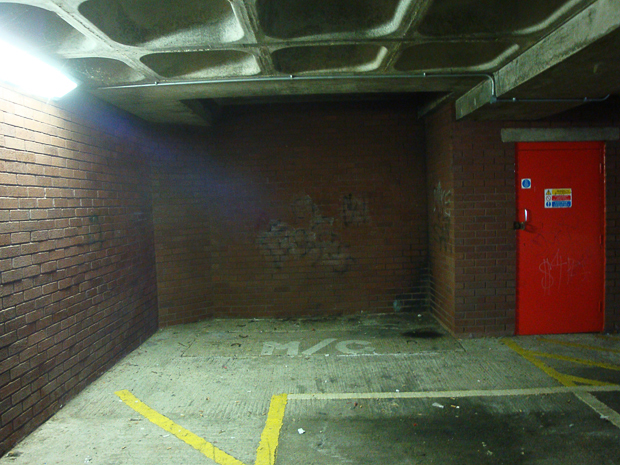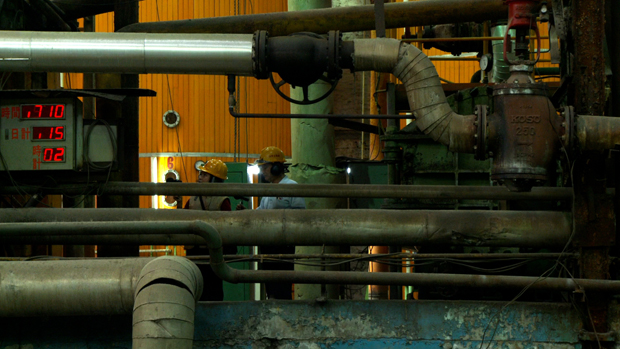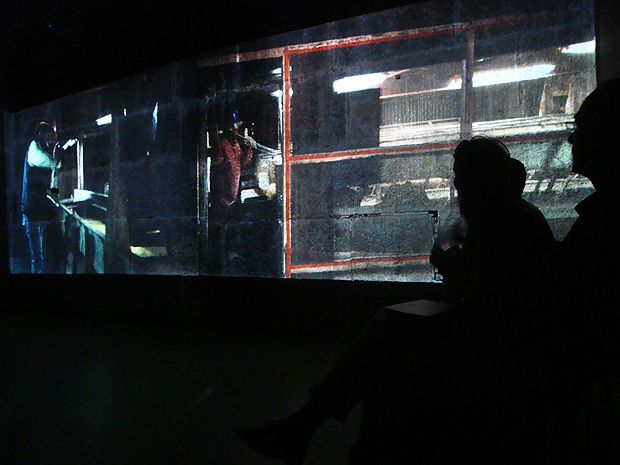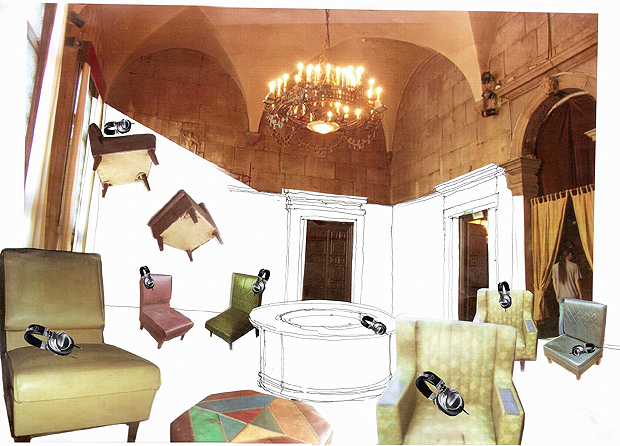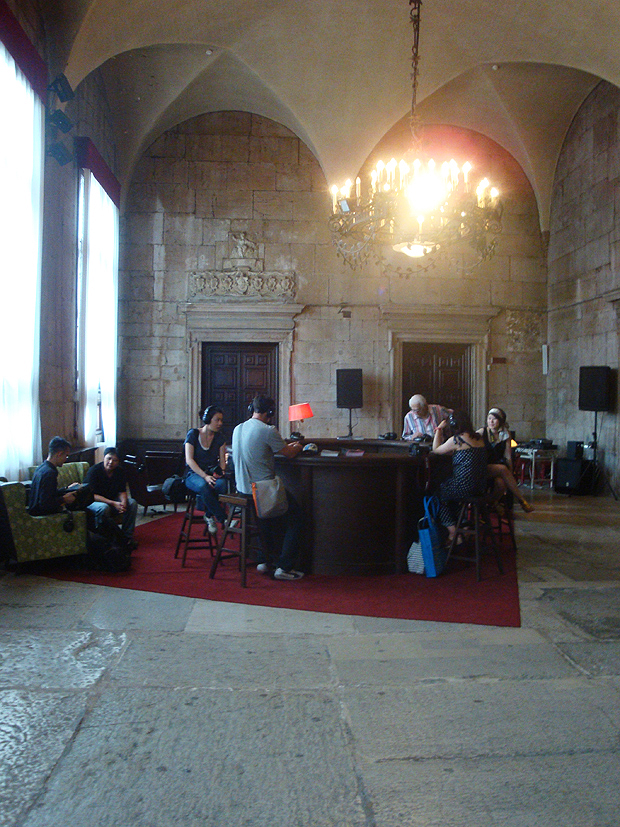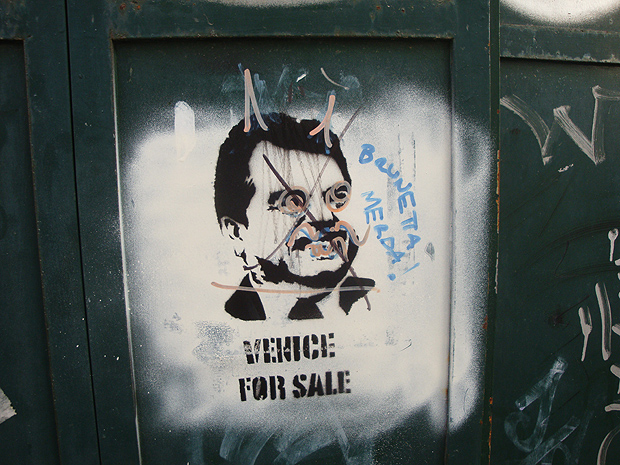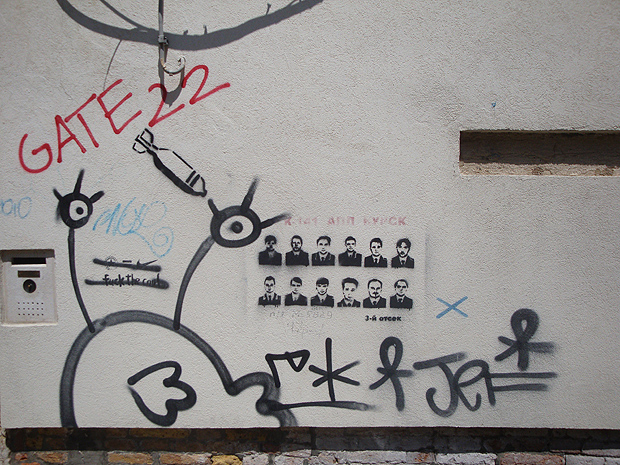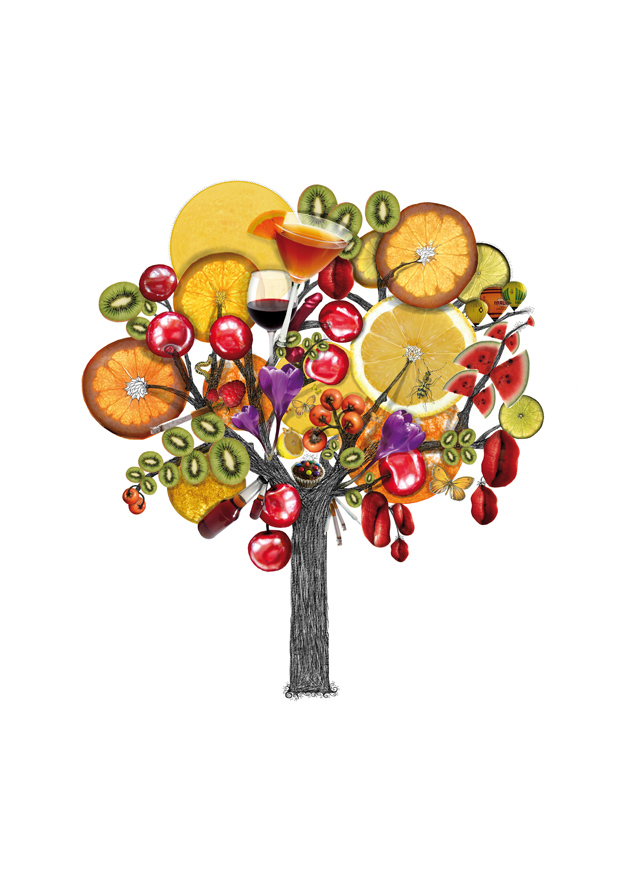NavinLand
Artist Navin Rawanchaiku's latest site-specific work at the 54th Venice Biennale converted the Paradiso Gallery and cafe into a unique presentation of Navinland. The audience is invited to participate with this constructed idea of 'paradise' by watching television broadcasts announcing the aims of Navinland, carrying Navinland flags and getting their special Navinland passports stamped. Using the language of government propaganda, movie posters, and sensationalist mass-media adverts the artist explores the idea of national identity by narrating the story of a fantastical Navinland. He portrays himself within these narratives as the central protagonist, leading the way to 'paradise.'
The Navinland Checkpoint at the entrance of the pavilion immediately reminded me of the long and difficult visa process preceding my 6 day visit to Venice. The process of getting a Navinland passport stamped made me laugh; it is a humorous and satirical way to look at the sad reality where based on your citizenship you are forced to endure longer queues and complicated bureaucratic processes just for a 6 day trip.
The Navinland posters below reflect two very different nations, America and China. It is interesting to note how the artist incorporates local mass media into his work based on context, place and audience.
Navinism 2007. Woodblock print on paper, 79.5 X45 cm/paper 100X70 cm (edition of 25).
Another comparison between two movie posters where the first one was exhibited in Mumbai and the second was a Seoul project two years later.
Navins of Bollywood Mumbai 2006.
Imagine Nabin. 2008. acrylic on canvas. 170X280 cm.
The artist is of Indian origin, was raised in Thailand and is currently settled in Japan so aspects of his mixed identity are often visible in his paintings. Here are some more images of his work:
Navin Rawanchaikul. Love Whispers from a Mayan Taxi. 2006 (collection: Jean-Miche Beurdeley and Patsri Bunnag). Photo by Tanapol Kaewpring.
"Win the masses in Their Millions for the Navin United Front" (May 7, 2007), Selected Works, Vol.1, p.12
Imagine Nabin, 2008, off-set, 10X15cm, 96 pages.
Navinland graffiti near the Thai Pavilion. Venice Biennale 2011. Photo by Aditi Kulkarni.
Reference: Rawanchaikul, N. 2011. Paradiso Di Navin: A Mission to Establish Navinland. Paradiso Gallery: Venice Mertens, B. 2008. The artist Navin Rawanchaikul calls for Navins of the world to unite. The New York Times. [online]. Available from: http://www.nytimes.com/2008/01/29/arts/29iht-mertens.1.9573662.html?_r=1. Accessed 25th July 2011.
Venice Biennale
20% of reasons NOT to be at the Venice Biennale.
20% of reasons not to be here - I found this list on a huge wall at the Giardini in Venice and it introduced me to the world of art and its politics in a whole new way. Visiting an art exhibition was a once in six months thing for me (before my MA). Most of my art knowledge comes from western books and the beautiful internet. So the Venice Biennale was an explosion in my head, and to represent it I choose the image below:

Its also interesting to look at the history of the event.
Sound Test
After reading people's comments and feedback on street sounds from Mumbai, research into the meaning of urban noise and visiting a few sound installations I decided to test the recordings. Phil helped me set up using an m-audio firewire box, a set of speakers and Logic Pro. The software is great to control specific channels of sound and play with traffic rumblings in real-time. The test helped me understand how such software can be used to make a room feel larger or smaller than it is. I also realized that the sound project was massive and needed another three months before it could move into a room on its own without visuals. I may still set up another test after the final show and record the results for the sake of experiment, since I loved mixing the noise together.


The test inspired me to begin learning the Quartz Composer, especially after seeing this work by Japanese artist Zugakousaku:
~
Group Critique 3
Other mentionable works where the audience completes the piece are Tall Ships by Gary Hill and Anthony McCall's work with light.
During the critique Charlie Murphy mentioned several interactive artists that could help inform my work. Paul Sermon's Telematic Dreaming is one such installation which explores real and projected audience interactions.
Other mentionable works where the audience completes the piece are Tall Ships by Gary Hill and Anthony McCall's work with light. Helen Maurer's use of projectors with mirrors is relevant because of relationships drawn between the real and virtual.
 High Tide 2006. by Helen Maurer. Overhead projector, glass, mirror and painted wood. [Image Source]
High Tide 2006. by Helen Maurer. Overhead projector, glass, mirror and painted wood. [Image Source]
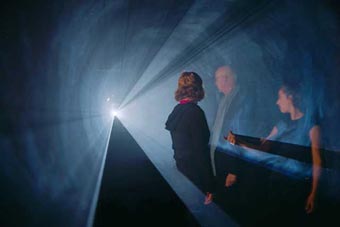 Anthony McCall. Line Describing a Cone. (1973, 16mm film) at the Whitney Museum exhibition “Into The Light,” 2001-2. Photograph © Henry Graber, 2002.
Anthony McCall. Line Describing a Cone. (1973, 16mm film) at the Whitney Museum exhibition “Into The Light,” 2001-2. Photograph © Henry Graber, 2002.
Charlie also mentioned the essay In Praise of Shadows by Jun'ichirō Tanizaki, which is a beautiful discussion of aesthetics and the conflict between west and east. Since my final work uses different types of shadows in the installation, Tanizaki's writing helped me look at metaphorical layers behind the shadow and differences in cultural meanings and perception. During the presentation some interesting quotes from Eyes of the Skin by Julian Pallasmaa caught my attention and when I had the book in my hands I discovered the chapter The Significance of the Shadow, which added to my increasing knowledge of how different theorists contextualize the shadow and its perceived meanings.
Reference Tanizaki, J. 1977. In Praise of Shadows. Leete's Island Books: USA Pallasmaa, J. 1996. Eyes of the Skin: Architecture and the Senses. John Wiley and Sons: USA
Fabrizio Olivetti
Olivetti is an Italian graphic designer and artist whose illustration work and posters span 30 years. At the exhibition On the Walls of Venice postcards, posters and catalogues of his work were distributed for free. Some of his work is shown below:Redentore 2002
1983.
1999.
[Notes: Images from the catalogue fuoridelcomune FabrizioOlivetti. Citta Di Venezia. On the walls of Venice exhibition. Venice Biennale 2011]
Audiosurf
A first attempt at recording my gameplay. Its interesting to look at this form of user-generated video, which is rapidly gaining popularity on the web.
A first attempt at recording my gameplay. Audiosurf was naturally my choice to try out this form of user-generated video, which is rapidly gaining popularity on the web.
Venice Streets
Lots of photos of venice streets and canals in this post. The next post will be Venice food! :) And pictures of venice graffiti are already up at my new art blog here.

It felt like a fantasy city. Lost tourists everywhere, traffic lights on the canals, and petrol pumps for taxi's which are speedboats. Gondola's are exorbitant and ridiculously expensive, but the entire venice experience is worth at least five days.
Dmitri Prigov
Curator Dmitri Ozerkov says that the main subject of Dmitri Prigov's art is "to create and develop objects as phenomena…language is a vehicle - egocentric, fragile, transparent and international - designed to store and communicate multiple meaning." Dmitri Prigov. Video and Sound Installation. Venice Biennalle 2011. Photos by Aditi Kulkarni.
You walk through several rooms parting curtains, each more disconcerting than the next. The last room of the installation is shown above. Repeating symbols such as the wine glass filled with blood and the 'void' also appear in his paintings, shown below:
Dmitri Prigov. Untitled [Idol] Paper, ballpoint pen. 42X29.5cm. The State Hermitage Museum, St. Petersburg. [Scanned postcard].
Dmitri Prigov. Series of Compositions with Tablets. Paper, ballpoint pen. 20.9 X 29.6 cm. The State Hermitage Museum, St. Petersburg. [Scanned postcard].
Dmitri Prigov. Series with the names of artists. Paper, ballpoint pen. 20.9 X 29.6 cm. The State Hermitage Museum, St. Petersburg. [Scanned postcard].
Dmitri Prigov. Series with windows. paper, acrylic, ballpoint pen. 21X30cm. The State Hermitage Museum, St. Petersburg. Untitled/Chairs/1996
The Hermitage is a Russian museum that chose the 54th Venice Biennale to introduce it's modern image by showcasing Dmitri's work. "The Hermitage 20/21 project's goal is to collect, exhibit and study art of the 20th-21st centuries. We want to create a collection of works that will become historic. Art can be viewed as a mirror of modern culture that reflects us all. Therefore, the Hermitage 20/21 is addressed to those people who want to be up to date, both amateurs and professionals, savvy connoisseurs and the youngest of viewers." [M. Piotrovsky, Director of the State Hermitage Museum].
Notes: Press Release. Dmitri Prigov: Dmitri Prigov. From the State Hermitage Collection. Hermitage Project 20/21. Dmitri Alexandrovich Prigov (1940-2007).
Neon Chandeliers
This gay shop in Venice was awesome, first because I've never seen a proper one - there are no sex shops in India, at least not in plain sight. Second because it is filled with neon chandeliers and paintings and guess what - a neon toilet called 'Water Closet Hotel' !
Lego City 2
The lego city project involves building an installation which expresses the conflict between real versus fantasy using multiple shadows and projections. The installation will be set up after the final show in September at a group exhibition called Out of Sight where about 25 artists are exhibiting their work at an abandoned car park in Winton. The essence of this place is appropriate for the installation, since it is inspired from Mumbai. Unlike the first Lego City which was set up in a studio, this version will have a greater impact because of it is site-specific. Here are a few pictures of the space:
Using lego arrangements made by artists and designers that attended my impromptu 'Lego Party' I will rebuild the lego city in the image of what others think a city or building should look like in Lego. Below is an example of one of these arrangements:
Crystal of Resistance
'But art is not resistance to something. It is resistance as such. Art is resistant because it resists everything that has already existed and been known. Art, as a resistance, is assertion, movement belief, intensity, art is 'positive.' Art resists tradition, morality and the factual world. Art resists every argumentation, every explanation and every discussion.'
Crystal of Resistance is a work by Thomas Hirschhorn. Below are a few lines from the catalogue where the artist talks about his philosophy on art:
'But art is not resistance to something. It is resistance as such. Art is resistant because it resists everything that has already existed and been known. Art, as a resistance, is assertion, movement belief, intensity, art is 'positive.' Art resists tradition, morality and the factual world. Art resists every argumentation, every explanation and every discussion.'
The artist uses the crystal as a repeating motif, transforming the gallery space into another world. I felt as if I'd been transported into a parallel universe, inexplicable and fascinating. The use of everyday objects such as ear-buds, brown tape, mirrors and mobile phones gives the entire work a surreal and disconcerting mood.
The Dali Universe
The Dali Universe was one of the few events where I decided the 10 euro entry fee was worth the resulting loss of food money. Profile of Time, 1977. Cast in 1984. The Dali Universe. Venice Biennale June 2011. Photos by Aditi Kulkarni.
Snail and The Angel. 1977.
Space Elephant 1980.
Dalinien lantern - Octahedrom 1987. Cube 1981. Tetrahedron 1981.
Adam and Eve 1968 Bronze Lost wax process
An interesting issue that comes up is that although the author of the work is Salvador Dali, several artisans were involved in the physical production of the various sculptures. Since their names are not listed, its important to recognize their anonymous and unmeasured contributions to the work. Other pieces worth noting were 'Flordali - Les Fruits', 'Poire Don Quixotte (pear) 1969' and 'Alice in Wonderland 1979-1999.' Some brilliant etchings were titled 'La Visa es Sueno 1973' but the available information was too brief. The exhibition staff here were pretty unhelpful with my barrage of questions. There could have been a language problem, I'm not sure. I also wanted a list of the all the artwork being displayed, but they didn't have that either.
Reference: Salvador Dali. 2011. The Dali Universe. Venice: Fondazione Ambrosiana Per L'Arte E La Cultura
The Heard and Unheard
'By constructing an "architectural music-space...made possible by the microphone," Music While We Work explores how artistic practice can intervence in the social space of labor production at the intersection of history and everyday life.'
At the Taiwan pavilion, artists' Hong-Kai Wang and Yi-Hsien Su created soundscapes that transformed the way I look at how sound can be used in installation work. Hong-Kai Wang's work especially connected with my attempts to use sound to comment on Mumbai's atmosphere and culture. She says,
'By constructing an "architectural music-space...made possible by the microphone," Music While We Work explores how artistic practice can intervene in the social space of labor production at the intersection of history and everyday life.'
Hong-Kai WANG. Music While We Work. Huwei, Yunlin, Taiwan. 2011. Audio and video installation. Video still by Yann Tonnar. Courtesy Hong-Kai WANG.Taiwan pavilion at Venice Biennale 2011. [Press Release].
Music While We Work by Hong-Kai Wang. (2011). Installation photo by Aditi Kulkarni. Taiwan pavilion at Venice Biennale 2011.
In addition to these two artists the sound bar had a wide variety of independent music and sound compositions from Taiwan to sample and enjoy.
Sound Library Bar design by Kuo-Chang Liu. Taiwan Pavilion. Venice Biennale 2011. [Press Release].
Sound bar library at Taiwan pavilion. Photo by Aditi Kulkarni. Venice Biennale 2011.
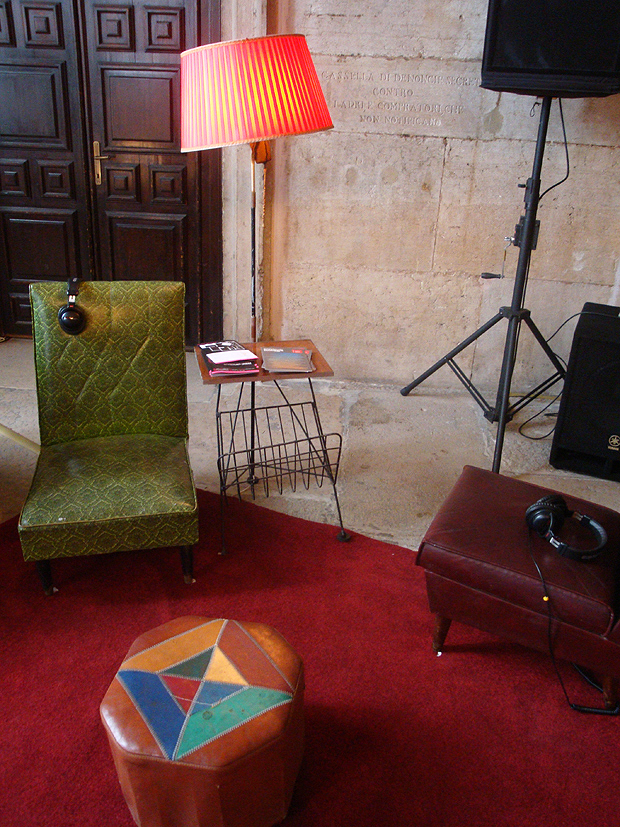 Sound bar library at Taiwan pavilion. Photo by Aditi Kulkarni. Venice Biennale 2011.
Sound bar library at Taiwan pavilion. Photo by Aditi Kulkarni. Venice Biennale 2011.
'I think the most important and uninvestigated architectural music-space of our time is the imaginary space made possible by the microphone...a space that does not exist in any form in any place in the everyday world.' (Ashley,r. 2009 cited in Hong-Kai Wang, 2011. p.17)
In her artist statement Hong Kai Wang quotes American avante-garde composer Robert Ashley, and I found these lines especially relevant. My aim is to transport the audience to Mumbai, my hometown and I agree that this relation between sound and essence of place, though immensely powerful is often ignored.
Reference: Hong-Kai Wang. (2011). Music While We Work. Venice: Palazzo Delle Prigioni. Notes: The Heard and the Unheard: Soundscape Taiwan. The Exhibition of theTaipei Fine Arts Museum of Taiwan. The Taipei Fine Arts Museum of Taiwan. Curator: Amy Cheng. Artists: Hong-Kai Wang Yu-Hsien Su.
Cracked Culture? Contemporary Chinese Art
Cracked Culture? The Quest for Identity in Contemporary Chinese Art. Curators: Wang Lin (China), Gloria Vallese (Italy). Organizer: Guangdong Museum of Art, China. Photos by Aditi Kulkarni.
Cracked Culture? The Quest for Identity in Contemporary Chinese Art. Curators: Wang Lin (China), Gloria Vallese (Italy). Organizer: Guangdong Museum of Art, China. Photos by Aditi Kulkarni.
 Jiao Xingtao. The Powerful Dragon. 258X38X170cm. Mixed Medium. 2011.
Jiao Xingtao. The Powerful Dragon. 258X38X170cm. Mixed Medium. 2011.
 Shi Jindian. Blue 750. Coloured Fibre in Stainless Steel. 260X170X120cm. 2008.
Shi Jindian. Blue 750. Coloured Fibre in Stainless Steel. 260X170X120cm. 2008.
Gao Yang. Jingzhe. Mixed Medium. 210X85cm. 2010.
Gao Yang. Mixed Medium 2011. Mixed Medium. 150X120cm. 2011.
 Ying Tianqi. Memory Loss. Mixed medium. 122X130cm. 2007.
Ying Tianqi. Memory Loss. Mixed medium. 122X130cm. 2007.
 Resi Girardello/ Vanas-Omnia Vincit Vanitas. Work with spun copper enameled in various colors and sizes, metal structure. 200X180X90cm. 2009.
Resi Girardello/ Vanas-Omnia Vincit Vanitas. Work with spun copper enameled in various colors and sizes, metal structure. 200X180X90cm. 2009.
 Ying Tianqi. Traces of the Vicissitudes. 2011.
Ying Tianqi. Traces of the Vicissitudes. 2011.
Ying Tianqi Resurrects the Life of Yore in the Old City on the Spot: "In China, when the bulldozers were marching like an army across the ancient city of Wuhu where I spent my childhood. I determined to shoot the record of this dramatic change with my video camera. Before the old city was demolished, I set my video camera at a sport shooting a street of neibhourhood and the life of a household from dawn till midnight for 12 hours. The same day a year later, that place had turned to ruins, and I played the video on the spot showing the life of people there a year before, both times of which happened to be the Chinese Dragon Boat Festival."
Future Pass
"Over 100 artists, both Asian and non-, offer a kaleidoscopic panorama of a new aesthetic paradigm currently proliferating from Asia to the rest of the world. Crossing genres and disciplines as they appropriate the digital culture of the 21st century, artists working in this eclectic new aesthetic are generating new types of relationships to the globalizing world."- Excerpt from the Short Guide distributed at the exhibition. Future Pass - From Asia to the World. Collateral Event Biennale Arte 2011. June 4th - Nov. 6th 2011.
 Kaikai Kiki/Chiho Aoshima. 1974-. Little Carefree, The Chicken Girl. FRP, Lacquer. 33X20X53 cm. 2008.
Kaikai Kiki/Chiho Aoshima. 1974-. Little Carefree, The Chicken Girl. FRP, Lacquer. 33X20X53 cm. 2008.
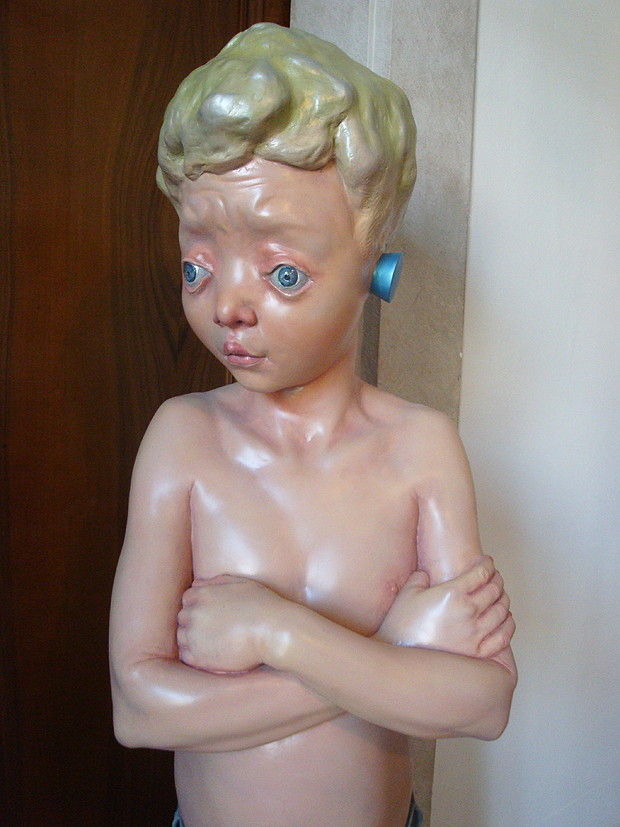 Yan Shi Lin. 1982-. What's the Matter. FiberGlass Paint. 2010.
Yan Shi Lin. 1982-. What's the Matter. FiberGlass Paint. 2010.
The word 'kaleidoscope' is an accurate description of this brilliant collection of work by a wide range of artists from across asia and the world. I spent hours here and didn't regret it for a moment (we had only 5 days to see the entire Biennale). If anyone asked me what the best thing to see in the Biennale was, it would be Future Pass. Several of the artists were also around when we visited, which made it an unforgettable experience.
 Andre Saraiva. 1971-. Mickey Wiagra. Polyester Resin, Strattee a structure - skeleton frame. 198X140X125 cm.
Andre Saraiva. 1971-. Mickey Wiagra. Polyester Resin, Strattee a structure - skeleton frame. 198X140X125 cm.
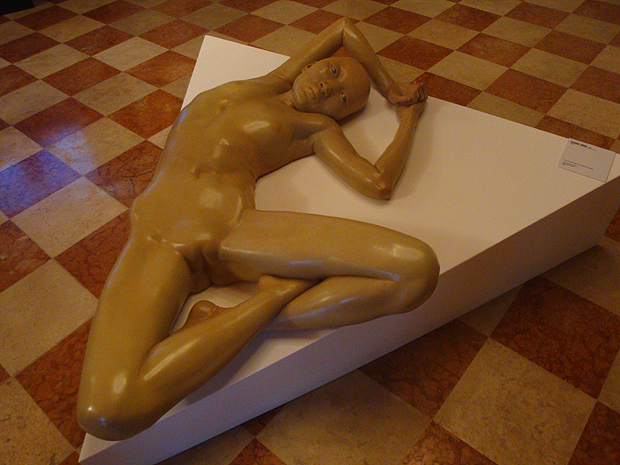 Xiang Jing. 1962-. I am 22 years old, but without my period. Fibre glass painted. 30X155X95 cm.
Xiang Jing. 1962-. I am 22 years old, but without my period. Fibre glass painted. 30X155X95 cm.
 Ward Walrath Kimball. 1914-2002. Untitled. Drawings on found posters. Sizes varied. Made in the 1960's.
Ward Walrath Kimball. 1914-2002. Untitled. Drawings on found posters. Sizes varied. Made in the 1960's.
 Victor Xu Weina. 1981-. (animamix.net). Magician. Fiberglass paint. 50X22X22 cm X3. 2009.
Victor Xu Weina. 1981-. (animamix.net). Magician. Fiberglass paint. 50X22X22 cm X3. 2009.
Kea. 1980-. A Salute to Fashion. Acrylic on Canvas. 162X130cm. 2011.
Wang Mai. 1972-. Using wisdom to capture the oil monster #12. Mixed material. 160X100X200 cm. 2011. [detail].
 Qu Yi. 1985-. Kiss Me Hard. Series of photographs.
Qu Yi. 1985-. Kiss Me Hard. Series of photographs.
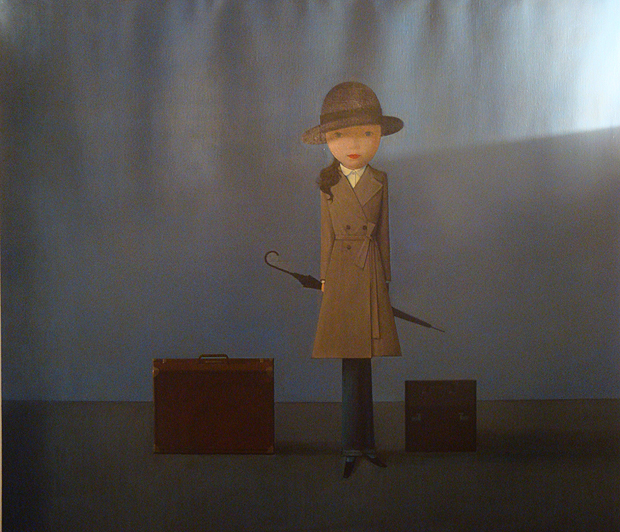 Liu Ye. Miss, 2008. Acrylic on Canvas. 140X160 cm. Private Collection.
Liu Ye. Miss, 2008. Acrylic on Canvas. 140X160 cm. Private Collection.
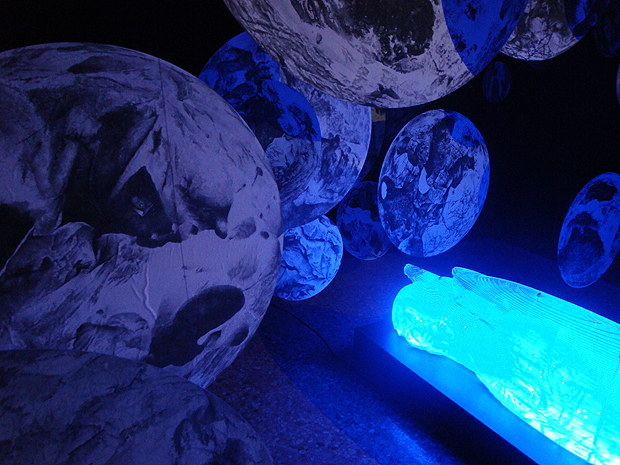 Li Hui. 1977-. Motor-Inherent Danger. Acrylics, LED Lamp, Stainless steel. 240X50X50cm. 2008.
Li Hui. 1977-. Motor-Inherent Danger. Acrylics, LED Lamp, Stainless steel. 240X50X50cm. 2008.
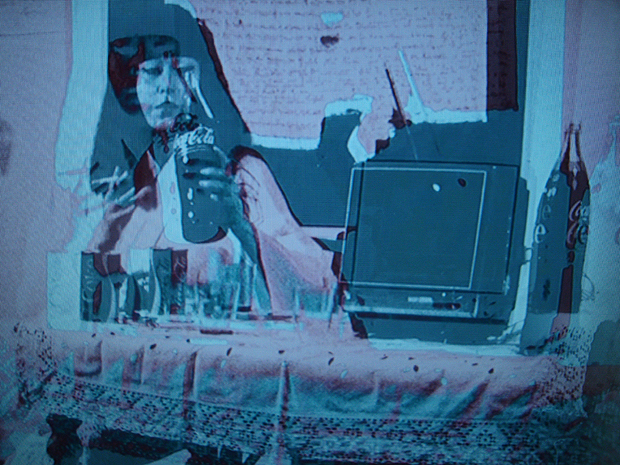 Yoko Toda. 1944-. Unknown Ideal. Video. 2009, 2011.
Yoko Toda. 1944-. Unknown Ideal. Video. 2009, 2011.
 David Chan. 1979-. Feeding the Stupid Monkey. Oil on Linen. 150X180 cm.2010.
David Chan. 1979-. Feeding the Stupid Monkey. Oil on Linen. 150X180 cm.2010.
 Cao Fei. 1978-. RMB City. Since 2009. Internet Project. RMB City is developed by Cao Fei & Vitamic Creative space. Facilitator: Uli Sigg. Courtesy of Artist and Sigg Collection.
Cao Fei. 1978-. RMB City. Since 2009. Internet Project. RMB City is developed by Cao Fei & Vitamic Creative space. Facilitator: Uli Sigg. Courtesy of Artist and Sigg Collection.
 Grimanesa Amoros. Uros Island. 414X340X66cm.
Grimanesa Amoros. Uros Island. 414X340X66cm.
Untitled Installation by Mu Lei. Video projection on a bathtub.
[Future Pass - From Asia to the World. Collateral Event Biennale Arte 2011. June 4th - Nov. 6th 2011. The UNEEC Culture and Education Foundation Taipei, The Today Art Museum of Beijing, The Wereldmuseum of Rotterdam, The National Taiwan Museum of Fine Arts, In Collaboration with the Fondazione Claudio Buziol of Venice, curated by Victoria Lu, Renzo di Renzo and Felix Schober].
The Walls of Venice
Photographs of graffiti and posters on the walls of venice, during the time of the venice biennale.
Exhibition at 60mpc
My poster exhibited at 60 mpc's This is the Start of Summer event.
My illustration work was sold at the event "This is the Start of Summer" at 60mpc, Bournemouth UK. Above are photos of the event and the illustration itself.
Stonehenge
A day trip to Stonehenge and nearby towns Amesbury and Salisbury is a must-do if you're in the area. Don't take the sight-seeing bus - it's loud and boring. Instead rent a car or walk the 2 kilometers from Amesbury to Stonehenge.
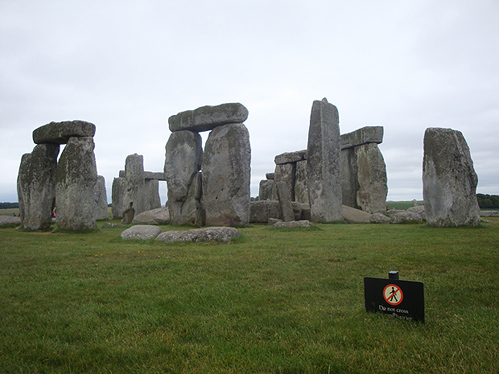
 One of the many burial mounds that surround Stonehenge. It's a nice walk if the weather is good.
One of the many burial mounds that surround Stonehenge. It's a nice walk if the weather is good.
 Two more burial mounds in the distance.
Two more burial mounds in the distance.
 A swan on the Avon river, we passed this on 45 min. walk back to Amesbury from Stonehenge.
A swan on the Avon river, we passed this on 45 min. walk back to Amesbury from Stonehenge.


























